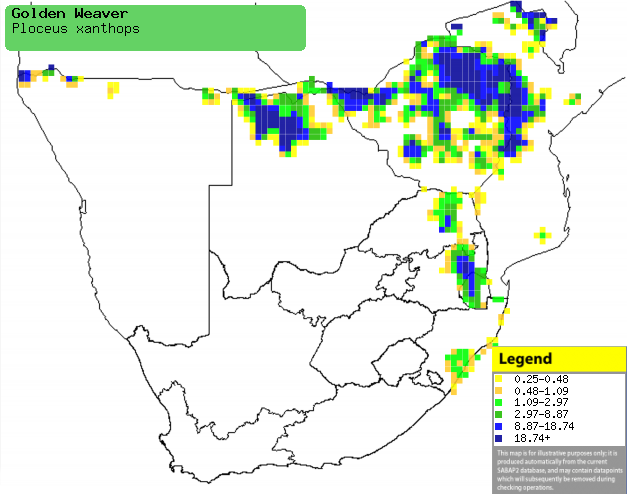|
Ploceus xanthops (Golden
weaver)
Goudwewer [Afrikaans]; iHlokohloko (generic term for weaver)
[Zulu]; Kambara (generic term for weaver) [Kwangali]; Jesa (generic name
for weaver) [Shona]; Sowa (generic term for weaver) [Tsonga]; Thaga
(generic term for weaver) [Tswana]; Saffraanwever [Dutch]; Tisserin safran
[French]; Großer goldweber, Safranweber [German]; Tecelão-dourado
[Portuguese]
Life
> Eukaryotes >
Opisthokonta
> Metazoa (animals) >
Bilateria >
Deuterostomia > Chordata >
Craniata > Vertebrata (vertebrates) > Gnathostomata (jawed
vertebrates) > Teleostomi (teleost fish) > Osteichthyes (bony fish) > Class:
Sarcopterygii (lobe-finned
fish) > Stegocephalia (terrestrial
vertebrates) > Tetrapoda
(four-legged vertebrates) > Reptiliomorpha > Amniota >
Reptilia (reptiles) >
Romeriida > Diapsida > Archosauromorpha > Archosauria >
Dinosauria
(dinosaurs) > Saurischia > Theropoda (bipedal predatory dinosaurs) >
Coelurosauria > Maniraptora > Aves
(birds) >
Order: Passeriformes > Family: Ploceidae
> Genus: Ploceus
Distribution and habitat
Occurs from Congo and Uganda through southern DRC, Zambia
and Angola to southern Africa. Here it is common from central Mozambique to
Zimbabwe, northern Botswana, the far north of Namibia (including the Caprivi
Strip) and eastern South Africa. It generally prefers grassy thicket along
forest edges, well-wooded savanna, riparian woodland and rank vegetation along
watercourses.
|
 |
|
Distribution of Golden weaver in southern Africa,
based on statistical smoothing of the records from first SA Bird Atlas
Project (©
Animal Demography unit, University of
Cape Town; smoothing by Birgit Erni and Francesca Little). Colours range
from dark blue (most common) through to yellow (least common).
See here for the latest distribution
from the SABAP2. |
Predators and parasites
Nests are sometimes torn apart by
African fish-eagles, who
then eat the chicks or eggs contained within.
Brood parasites
It has been recorded as host of the
Diderick
cuckoo.
Food
It eats a variety of fruit, insects, seeds and nectar,
doing most of its foraging in dense vegetation. The following food items have been recorded
in its diet:
- Plants
- fruit
- Ficus (figs)
- Rhus pyroides (Common currant)
- seeds
- Panicum maximum (Guinea grass)
- Pinus patula (Patula pine)
- nectar
- Ruttya (rabbit ears)
- Erythrina (coral-trees)
- Arthropods
Breeding
- Usually monogamous but occasionally polygynous, as males may breed singly
or in loose colonies of 2-3 males.
- The male builds 1-5 nests (see image below), consisting of an untidy,
bulky kidney-shaped structure made of woven coarse grass, which is lined by
the female with grass inflorescences and plant down. It is typically
attached to a drooping branch or suspended between to reeds or grass stems.
- Egg-laying season is from August-April, peaking from October-February.
- It lays 1-3 eggs, which are incubated solely by the female for about
14-15 days.
- The chicks are fed by both parents but mainly the female, leaving the
nest after about 19-21 days.
Threats
Not threatened.
References
-
Hockey PAR, Dean WRJ and Ryan PG 2005. Roberts
- Birds of southern Africa, VIIth ed. The Trustees of the John Voelcker
Bird Book Fund, Cape Town.
|
